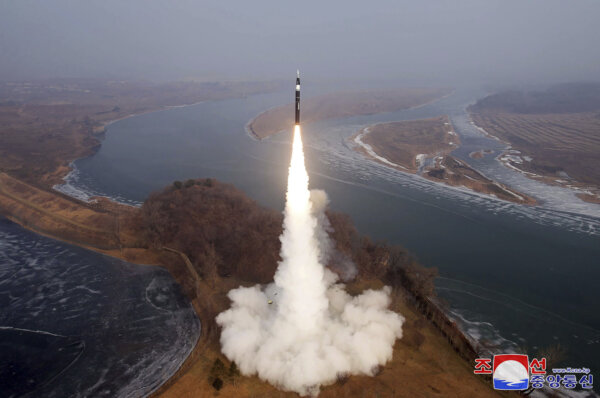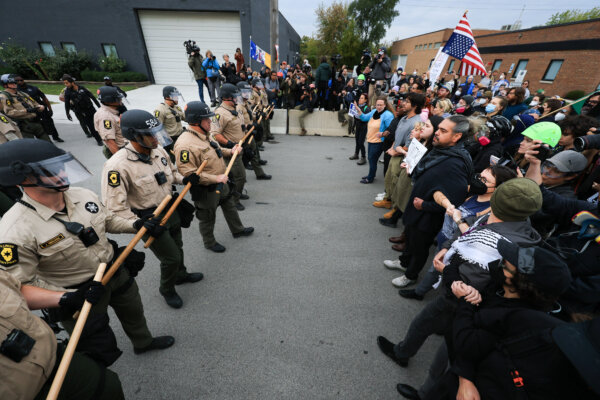![]() North Korean leader Kim Jong Un must be sweating bullets now that Israel’s 12-day air bombardment and special operations campaign against Iran eliminated its air defenses, clearing the way for President Donald Trump’s “Operation Midnight Hammer,” the culmination of a 15-year effort to develop weapons, including the GBU-57 Massive Ordinance Penetrator, that can reach almost 300 feet down to obliterate Iranian nuclear facilities.
North Korean leader Kim Jong Un must be sweating bullets now that Israel’s 12-day air bombardment and special operations campaign against Iran eliminated its air defenses, clearing the way for President Donald Trump’s “Operation Midnight Hammer,” the culmination of a 15-year effort to develop weapons, including the GBU-57 Massive Ordinance Penetrator, that can reach almost 300 feet down to obliterate Iranian nuclear facilities.
Tehran is Pyongyang’s ally, and North Korea also relies on hundreds of underground bunkers. But Kim is also racing to secure his burgeoning land-based nuclear missile arsenal by creating a sea-based “second strike” nuclear force to be deployed in defended naval “bastions” to deter any “first strike” against his land-based nuclear forces.
North Korea is already very different from Iran. Trump and Israeli Prime Minister Benjamin Netanyahu chose to attack Iran’s nuclear weapons program as it was on the verge of developing its first weapons. In contrast, North Korea long ago passed this point, as successive U.S. administrations failed to compel its nuclear disarmament with strategies of political-economic sanctions.
But key to North Korea’s refusal to disarm has been consistent Chinese and now likely Russian support for Pyongyang’s nuclear weapon and missile developments, which Washington and its allies failed to stop.
The result is that over the last 20 years, North Korea has “built” successive liquid-fueled and solid-fueled intercontinental ballistic missiles (ICBMs), liquid and solid-fueled medium-intermediate range missiles, long-range land and sea-launched land attack cruise missiles, and tactical nuclear-armed unmanned underwater vehicles.
To protect these forces, North Korea is now building nuclear missile submarines and warships to implement a pro-submarine “bastion” strategy mirroring that of China, the likely main source of Pyongyang’s missile, submarine, and warship technology.
Pro-submarine bastion naval strategies originated in the 1950s with the late Soviet Navy Admiral Sergei Gorshkov, who, lacking aircraft carriers, exploited favorable geography in the Atlantic off the Kola Peninsula and the Pacific Kamchatka Peninsula, to enforce protected nearby zones for nuclear ballistic missile submarines (SSBNs) with nuclear attack submarines, missile-armed warships, and land-based missile-armed bombers.
This was ultimately Gorshkov’s strategy to convince a Soviet military leadership dominated by army officers to fund his navy, whereas the post-Mao Chinese Communist Party (CCP) has always desired a full nuclear and power-projection navy.
The Chinese regime likely began implementing its pro-SSBN bastion strategy in the late 1960s when it began planning its second-generation nuclear ballistic missile submarine, having also decided these required South Sea Fleet basing near deep waters off of Hainan Island (more than 16,000 feet), thus beginning the CCP’s active campaign to gradually take control of the South China Sea.
The CCP’s People’s Liberation Army (PLA) now controls more than 20 island bases in the Paracel Island Chain, including the large air-missile-naval base at Woody Island, edging a first circle of defense around Hainan Island, now joined to the south by three large air-missile-naval bases in the Spratly Island Chain to form a second defended circle to secure South Sea Fleet SSBNs.
In mid-May, the U.S. Defense Intelligence Agency estimated that by 2035, China could have 132 submarine-launched ballistic missiles (SLBMs), or up to 11 nuclear ballistic missile submarines, assuming a current loadout of 12 SLBMs per SSBN.
As such, the PLA Navy has likely been seeking a second defended SSBN bastion area, as Taiwan and Japan surround its East Sea Fleet, while the North Sea Fleet only has access to the relatively shallow (200–300 feet) Yellow Sea.
The CCP likely decided, after the 2003 Gulf War, to first help North Korea become an ICBM power, followed by assistance to help Pyongyang acquire second-strike SSBNs and the means to protect them. Kim announced his intention to build nuclear submarines in late 2021.
China’s ICBM program for North Korea was revealed during Pyongyang’s April 15, 2011, military parade, which included a new ICBM mockup being carried by a very real China Aerospace Science and Technology Corporation (CASIC) 16-wheel transporter-erector-launcher (TEL). This culminated in the Oct. 31, 2024, launch of the Hwasong-19, the world’s largest solid-fuel, mobile ICBM carried on the world’s largest 22-wheel TEL, clearly also designed by CASIC.
China’s likely role in helping North Korea build new nuclear-powered and nuclear missile-armed submarines likely stems from Pyongyang’s program to make its first large non-nuclear-powered but nuclear missile-armed submarine (SSK), launched in September 2023.
This SSK has a diameter of about 22 feet. Still, it is a radical 10-vertical-launched missile modification of North Korea’s Chinese-built Type 033 diesel-electric-powered attack sub, looking much like the Chinese navy’s former Type 031 SSK, which was based on the partially built 1950s vintage Soviet-era Project 629 “Golf” SSK.
In the mid-1990s, North Korea acquired up to 12 non-operating ex-Soviet “Golf-II” SSKs via a Japanese trading company, raising the possibility that either Chinese or Russian engineers (or both) could have assisted North Korea’s SSK—and the following nuclear-powered missile submarine.
On March 8 this year, North Korean state media released images of Kim at a shipyard, walking past portions of the large cylindrical hull, which they described as a “nuclear-powered strategic guided missile submarine.”
In his blog on March 8, noted submarine expert H.I. Sutton estimated this submarine’s diameter as 12.5 meters (41 feet), while South Korean Hanyang University expert Moon Keun-Sik estimated this nuclear missile submarine’s displacement to be 6,000 to 7,000 tons.
This is noteworthy inasmuch as China’s first-generation Type 092 SSBN displaced about 8,000 tons while the Soviet’s first-generation Project 667 “Yankee” SSBN displaced 7,000 to 9,000 tons.
The Chinese regime has long pursued a strategy of altering the designs of strategic nuclear and conventional weapons that it sells to rogue states. So if, when revealed, the North Korean SSBN looks more like a Soviet-inspired design, the chances are greater that China provided most of the design assistance.
China and Russia are unlikely to give North Korea their most modern nuclear submarine quieting technology, meaning that Kim is going to have to keep his SSBNs close and protect them—the Bastion strategy.
Kim revealed his intention to protect his SSBNs and SSKs at the end of December 2024, when, during a visit to a shipyard, he unveiled a nearly completed 5,000-ton destroyer (DDG). The destroyer was then completed and commissioned by Kim in a ceremony on April 25.
Kim’s DDG, named Choe Hyon, is armed with a whopping 98 missiles, including 10 large vertically launched ballistic missiles, between four and eight land attack cruise missiles, both of which can be nuclear armed, a new vertically-launched torpedo-armed anti-submarine missile, and both short- and medium-range anti-aircraft missiles.
This DDG is equipped with what appears to be an advanced active electronically scanned array radar and advanced electronic warfare defenses, likely giving it the ability to take down attacking anti-ship missiles.
A second DDG fell on its side during a May 21 launch ceremony, and though embarrassing for Kim, this damaged destroyer was quickly refurbished for a June 13 formal launch ceremony.
More bastion-protection ships are coming. In an April 25 speech, Kim said, “We will, of course, build combat ships of this class next year as well, and we plan to build larger cruisers and various escort ships with higher operational capabilities as soon as possible.”
Kim’s creation of defended bastions for his SSBNs and SSKs would primarily benefit China, which can be expected to sell North Korea advanced seabed-mounted sensors to further protect these bastions. Additionally, China may press Russia to sell North Korea modern jet fighters to bolster air defense for these areas.
A North Korean bastion in the relatively shallow Yellow Sea would give Chinese Northern Fleet submarines an additional place to hide while attempting to break out to deeper waters of the East China Sea.
But a North Korean bastion located off the country’s northeast coast would offer access to waters deeper than 10,000 feet, potentially giving North Korean and Chinese SSBNs a defended bastion area that would reduce flight times for Chinese submarine-launched ballistic missiles attacking U.S. targets, increasing chances of evading U.S. Golden Dome missile defenses.











